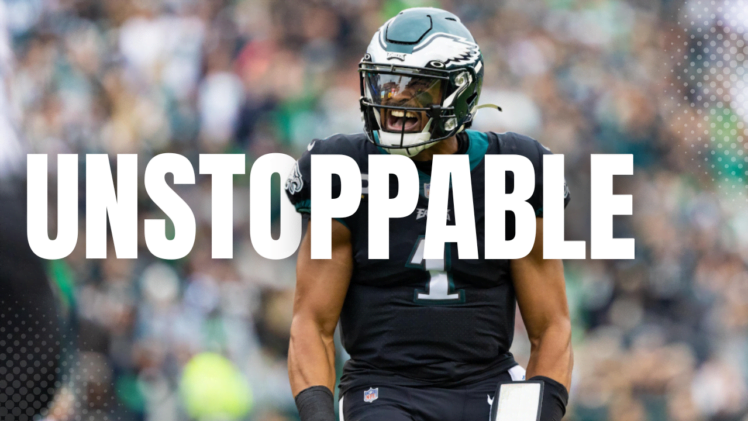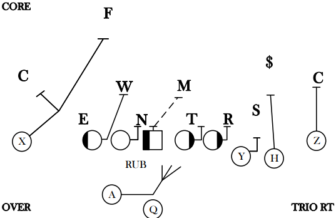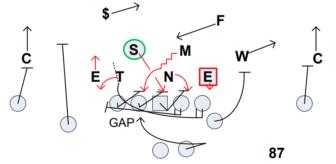
The Philadelphia Eagles offense and quarterback Jalen Hurts are running wild. They aren’t reinventing the wheel, they’re just really good at what they do. They have combined some of the most popular college systems into an impressive offensive attack. They’re using a read-option rushing attack with both gap and zone schemes while combining the explosiveness of the Air Raid system through the air.
The Eagles offense starts on the ground. They don’t use an excessive amount of motion, but they put defenses into extreme conflict with defender reads and RPOs. By using Jalen Hurts as a runner, they are equaling the playing field and the inherent numbers advantage that all defenses have. They find ways to create reads and force defenses to think and react on the fly. What that does, is force defenses to bring an extra defender to account for Jalen Hurts. With more defenders contributing to the run and attaching to RPOs, the Eagles end up seeing a good amount of man coverage. That’s where the Air Raid portion of the offense starts to take off.
Air Raid is known for using concepts like Mesh and Four Verticals to create immense vertical and horizontal stress on the defense. Conventional Air Raid offenses combine that passing attack with a vertical run game and high tempo – which the Eagles also sprinkle in. They certainly run more gap scheme and inside zone than they do schemes that stress the edges of the defense. If they find a weakness, they’re going to run the same exact concept over and over again until you stop it.
In their most recent game against the New York Giants, they ran literally the same formation, motion, and Guard/H counter concept three times in a row and seven times in the game. Not once did they lose yardage and they got numerous explosive plays out of it. Against the Packers, they ran a Dart Trap concept seven different times as well. Again, without one play going for negative yards.
The Eagles are simply unafraid of anything the defense gives them and is confident that if you take something away, they have the personnel and scheme that will make you pay for it.
Inside Zone
Read Option
Zone Read
The Eagles’ offense starts with their read option on zone. Whatever the blocking scheme upfront, Jalen Hurts is reading the backside defensive end man on the line of scrimmage for whether he will give the ball or keep it himself. If that player crashes down the line to attack the running back, Hurts will keep it. If the player sits, he hands the ball off. The concept itself is simple, but it challenges defenses immensely when the quarterback is a running threat.
Split Zone
That base read concept builds. The next step is to run split zone with the same read and either inside or wide zone as the run scheme. The split in split zone refers to the H-back coming across the formation on the snap and blocking the opposite defensive end (previously unblocked read man). That kickout block adds one more thing for that defensive end or linebacker to think about. First, he’s being read and has to diagnose whether to chase the running back or quarterback. Now, while he’s trying to do that, the H-back is coming across and kicking him out.
Not only is that defensive contain player having to deal with multiple looks, but the linebackers are now also put into conflict. To deal with the issue of the read option, defenses will sometimes have their end man on the line of scrimmage chase the running back no matter what. That gives Jalen Hurts the read to keep the ball. Behind that defensive end, the linebacker will gap exchange and loop around to be the force player responsible for Hurts so that he’s running right into a linebacker that isn’t accounted for.
When run with split zone, the linebacker also needs to be aware of the possibility of the H-back releasing into a route across the formation. As we see here, the linebacker tracks with the H-back, the H-back kicks out the end, and that gives a numbers advantage on the handoff to Miles Sanders. Meanwhile for the offensive line, it’s their basic zone running play. Nothing has to change for them, but the defense is being challenged with backfield action.
Split Zone Lead
To further complicate things, the Eagles love to run their split zone action, but instead of the H-back kicking out the end, he will leave him and lead block for Jalen Hurts on the keep. Now, it’s back to being a true read option and the end is seeing an H-back coming across the formation, having to diagnose the handoff, and being unsure whether that H-back is going to kick him out or run right by him. The end result, is a numbers advantage for the offense and opportunities for explosive plays with an additional blocker to the keep side of the play.
As we touched on briefly with the gap exchanges that defenses do, the Bears and head coach Matt Eberflus executed it by far the best of the season. Generally, when facing read option teams, the defense wants to pick who they feel is the worse runner and force that player to carry the ball. In this case, they wanted to force Hurts to be the primary ball carrier which has a multilayered approach. You get to put hits on the quarterback and you get what, in their view, is the better runner out of the picture in Miles Sanders.
The Bears ran a ton of linebacker gap exchange to combat the read option from the Eagles. Play after play, the end would chase down the line and signal to Hurts to keep the ball. The backside linebacker would then exchange gaps and protect outside. That would contain Hurts and funnel him inside towards the safety and playside linebacker who can scrape to make the play. That strategy, combined with some slants and stunts on the defensive line, held the Eagles to under four yards per carry and just barely over 100 rushing yards on the day.
Football 101: Defensive Stunts
Gap Scheme
GH Counter
While their zone read game is a problem in itself, Philadelphia has had a ton of success running Counter, Counter Bash read, and Dart. The Eagles love to run GH Counter which uses the guard to kick out the end and the H-back wrapping through. As mentioned before, they ran it seven times against the Giants. The Eagles offensive line are maulers at the point of attack and great at downblocks and creating vertical displacement on the defensive line.
Counter
Counter Bash
The Eagles also like to run what’s called Counter Bash with the running back going the opposite direction of the run scheme and the quarterback reading whether to keep it and run the counter himself. In the Eagles’ version of Counter Bash, Hurts reads the backside linebacker. They feel like with how passive ends tend to play them for zone reads, that they can get around that player and instead read the second level. If the linebacker sits and doesn’t chase the mesh of the running back outside, Hurts will hand the ball off. If they do move with the back, Hurts keeps the ball and runs counter himself. It is, again, putting immense strain on the defense. There are two additional pullers going one direction and adding blockers, but if you chase the pullers, they can get outside of you on the handoff.
Dart
The next most common iteration of their gap scheme is Dart or Dart Trap. Dart is essentially the same scheme as power, but with the tackle pulling instead of the guard. As mentioned before, they will run the absolute hell out of it if you can’t stop it. With the Eagles reading the defensive end so much, when they pull the tackle, that end often doesn’t chase because of the fear of Hurts keeping the ball. It fits right into their zone read scheme and adds another blocker to the playside of the run. If they are worried about that end crashing, they’ll usually plug in a tight end and have him cut that player off to prevent the chase down the line of scrimmage.
Dart Trap
Dart trap still has the tackle pulling, but the offense leaves a defensive tackle unblocked to get “trapped” by the tackle. It’s a vertical hitting play that gives yet another look to a different member of the defense. Using the same general scheme with simple tags is what makes the Eagles offense so absolutely insanely difficult to defend. They can block you from any direction, they can read you, they can pull their linemen, they can double team you and move you vertically, the quarterback can run, and Miles Sanders is no slouch himself.
Pass Game
And all of that is just the running game. Because of how teams have to play their run game, Philadelphia often sees man coverage and single-high safeties. That’s where the Air Raid concepts come in. If you have man coverage, verticals and rub routes are killer. The Eagles have no fear if they see matchups in man coverage. They are eager to take shots to Devonte Smith and AJ Brown and to get their receivers running horizontally with speed on Mesh.
When a team can beat you over the top while also being able to run down your throat, you’re in a bad spot. The most successful teams have been able to keep a two-high shell, gap exchange, and slant on the defensive line. That way they don’t leave their corners on islands and can disrupt things on the Eagles’ offensive line. There’s only a few teams in the league that have the personnel and scheme to be able to do that, though. Philadelphia is perfectly content to run quick game, keep the ball on the ground, and eat up yardage all the way down the field. They run what works and they run it until you stop it. And right now, it doesn’t seem that anybody can stop the Eagles.



